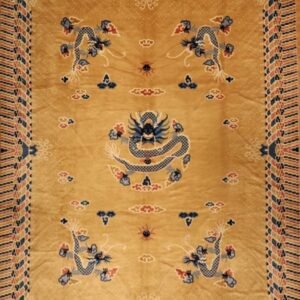Serial No.: 0009759
Origin: Perepedil, Kuba, Caucasia
Age: Dated 1939
Style: Tribal Size: 5′ x 7′ 3”
Material: Wool Foundation, Wool Pile, Vegetable Dyes
Color Scheme: Navy, Ivory, Red, Green, Yellow, Black
Origin & Historical Context
Dated to 1939, this Perepedil rug from the Kuba district of the Caucasus exemplifies a transitional moment in tribal weaving: it preserves the aesthetic and technical hallmarks of 19th-century Caucasian rugs while reflecting a more recent era in regional carpet production. Perepedil weavings are historically prized for their precise drawing and symbolic motifs, linking them to the broader tradition of Kuba rugs, which are known for their fine knotting and intricate geometric patterns.
Center Field in Navy
A defining feature of this piece is its navy center field, which serves as the canvas for a dynamic array of tribal motifs. Characteristic of Perepedil rugs, the field is populated by stylized horn shapes, star-like floral elements, and occasional zoomorphic or abstract forms. The color palette—red, green, yellow, black, and ivory—contrasts sharply against the deep navy ground, creating a striking visual interplay. These motifs often carry protective or symbolic significance within Caucasian weaving communities, speaking to the cultural narratives embedded in each knot.
Intricate Border Details
Encircling the central panel is a multi-tiered border system that underscores the rug’s meticulous craftsmanship. The primary border typically features repeating geometric medallions or meandering vines, each rendered in saturated hues that echo the rug’s interior. Multiple guard borders, often adorned with reciprocal trefoil or latch-hook motifs, further enhance the sense of depth and definition. This structured framing balances the energy of the central field, highlighting both the precision and the layered complexity of Perepedil design.
Technical Weaving & Natural Dyes
Constructed on a wool foundation with a wool pile, the rug employs symmetrical (Turkish) knots, known in the region for providing clarity of design and resilience under foot traffic. The use of vegetable-based dyes—sourced from local plants and minerals—lends a naturally variegated quality (abrash) to the colors, enhancing the rug’s artisanal character. Despite being woven in 1939, it retains the traditional weaving methods and dyeing processes passed down through generations of Caucasian weavers.
Hints from the Era & Suggested Use
Although this rug dates slightly later than many 19th-century examples, it remains firmly rooted in the tribal aesthetics that have long defined Perepedil textiles. It likely emerged during a period when traditional weaving still dominated rural life, yet outside influences were beginning to appear in pattern stylization and color choices.
In a contemporary setting, this 5′ x 7’3″ rug serves as a versatile accent piece—ideal for grounding a small living room, study, or entryway. Its robust construction and vibrant palette allow it to integrate into both traditional interiors—where it can harmonize with antique furnishings—and more eclectic or modern spaces, offering a rich cultural narrative in a visually compelling form.
Overall, this Perepedil rug stands as a testament to the enduring legacy of Caucasian weaving, merging the symbolic depth of tribal art with the technical sophistication that collectors and enthusiasts continue to cherish.







Reviews
There are no reviews yet.